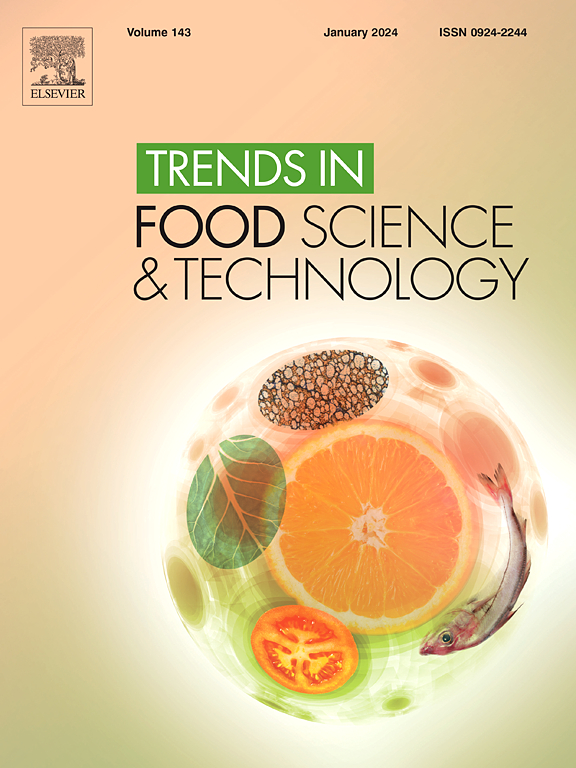豆科加工水化废水中多酚和低聚糖的浸出及回收策略
IF 15.1
1区 农林科学
Q1 FOOD SCIENCE & TECHNOLOGY
引用次数: 0
摘要
水化是豆类罐头加工的关键阶段,但它往往产生相当数量的废水。大量的生物活性物质,包括(多)酚和低聚糖,浸出到废水中,导致加工成本增加,并损害罐头产品的营养特性。为了可持续生产,迫切需要回收这些物质。本文综述了豆科植物水化废水中多酚和低聚糖的回收策略。我们首先探讨了这些成分损失和浸出到豆科植物水化废水中的潜在原因。概述了废水中(多)酚和低聚糖的分布。在新兴的回收技术中,我们有选择地关注两种技术的组合使用:大孔树脂(MR)吸附/解吸和膜工艺。主要发现和结论热因素是生物活性物质损失的重要因素。每一种豆科植物产生的水化废水都具有独特的(多)酚类物质,包括花青素、黄烷醇、黄酮醇、单宁和酚酸,以及主要属于棉子糖家族的低聚糖。当MR被用来有效地分离(多)酚和低聚糖时,纳滤膜(150-400 Da)随后被用来纯化这些成分。增值性能高度依赖于原料的物理化学性质、树脂/膜类型和操作条件。这一综述将有助于进一步优化特定豆科植物的增值系统。虽然超出了范围,但技术经济分析对于评估未来发展的可行性和可扩展性至关重要。此外,利用豆类废物不仅促进可持续性,而且通过功能性食品生产增强消费者健康,同时通过减少生产废物支持环境可持续性。本文章由计算机程序翻译,如有差异,请以英文原文为准。
Leaching and proposed recovery strategies of (poly)phenols and oligosaccharides from hydration wastewater during legume processing
Background
Hydration is a critical stage in the processing of canned legumes, yet it often generates a considerable volume of wastewater. Large amounts of bioactive substances, including (poly)phenols and oligosaccharides, leach out into the wastewater, resulting in increased processing costs and compromising the nutritional properties of the canned product. For sustainable production, there is an urgent need to recover these substances.
Scope and approach
This manuscript comprehensively reviews the recovery strategies for (poly)phenols and oligosaccharides from legume hydration wastewater. We first explore the potential causes of the loss and leaching of these components into the legume hydration wastewater. The profiles of (poly)phenols and oligosaccharides in the wastewater are outlined. Among the emerging recovery technologies, we selectively focus on the combined use of two techniques: macroporous resin (MR) adsorption/desorption and membrane processes.
Key findings and conclusions
Thermal factors are a significant contributor to the losses of bioactive substances. Hydration wastewater generated from each specific legume cultivar exhibits a unique (poly)phenolic profile, including anthocyanins, flavanols, flavonols, tannins, and phenolic acids, and oligosaccharides mostly belonging to the raffinose family. While MR is employed to effectively separate (poly)phenols and oligosaccharides, nanofiltration membranes (150–400 Da) are subsequently utilized to purify these components. The valorization performance is highly dependent on the physicochemical properties of feed materials, resin/membrane types, and operational conditions. This review is expected to facilitate future efforts to optimize the valorization system for specific legumes. While out of scope, techno-economic analysis will be crucial for assessing feasibility and scalability in future developments. Moreover, utilizing legume waste not only promotes sustainability but also enhances consumer health through functional food production while supporting environmental sustainability by minimizing production waste.
求助全文
通过发布文献求助,成功后即可免费获取论文全文。
去求助
来源期刊

Trends in Food Science & Technology
工程技术-食品科技
CiteScore
32.50
自引率
2.60%
发文量
322
审稿时长
37 days
期刊介绍:
Trends in Food Science & Technology is a prestigious international journal that specializes in peer-reviewed articles covering the latest advancements in technology, food science, and human nutrition. It serves as a bridge between specialized primary journals and general trade magazines, providing readable and scientifically rigorous reviews and commentaries on current research developments and their potential applications in the food industry.
Unlike traditional journals, Trends in Food Science & Technology does not publish original research papers. Instead, it focuses on critical and comprehensive reviews to offer valuable insights for professionals in the field. By bringing together cutting-edge research and industry applications, this journal plays a vital role in disseminating knowledge and facilitating advancements in the food science and technology sector.
 求助内容:
求助内容: 应助结果提醒方式:
应助结果提醒方式:


